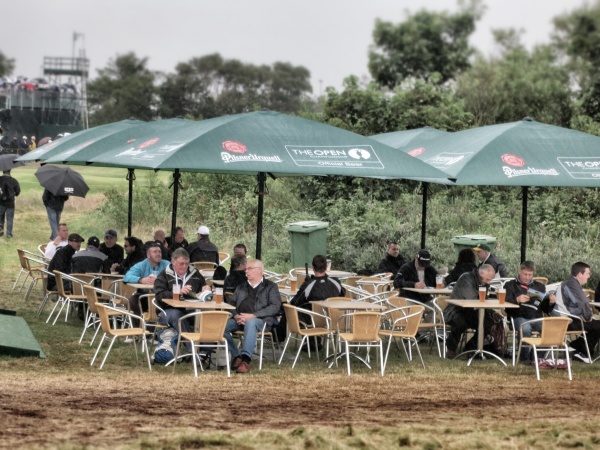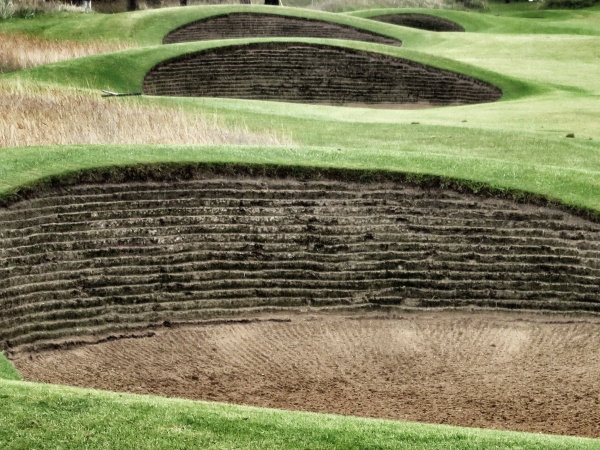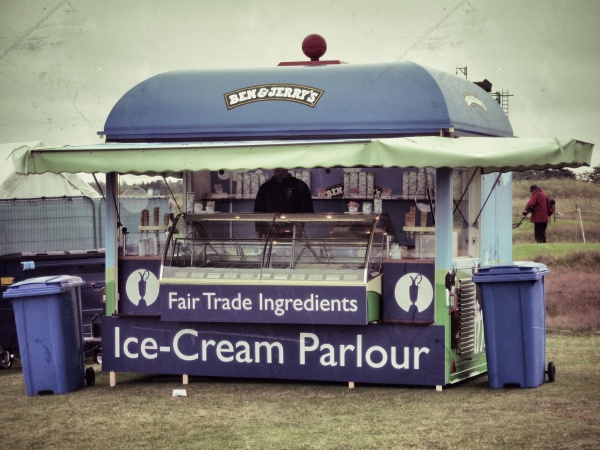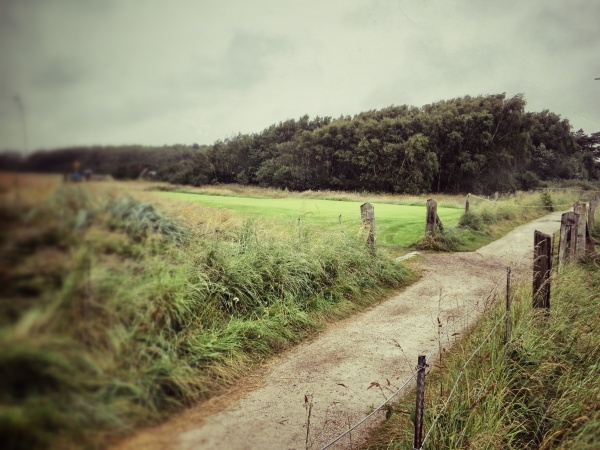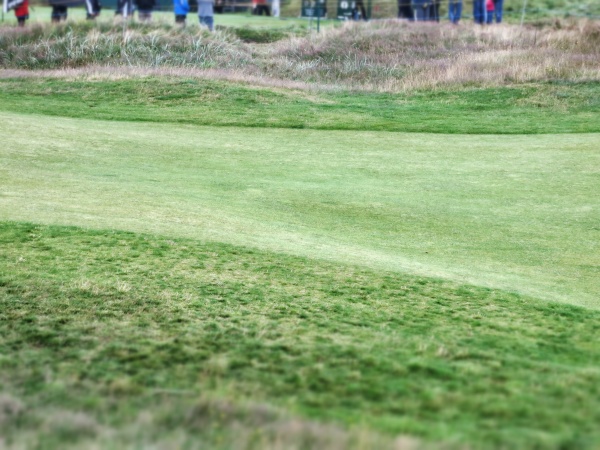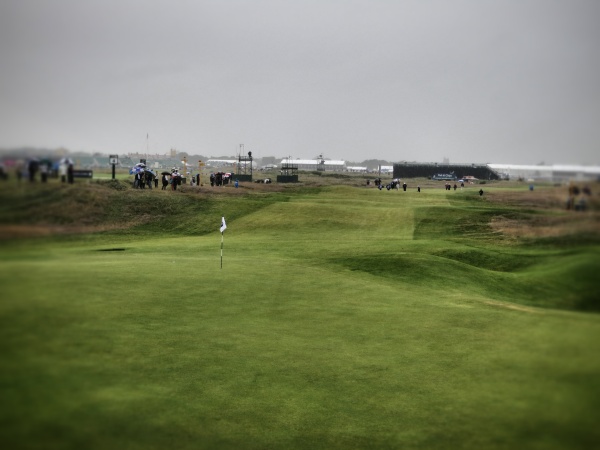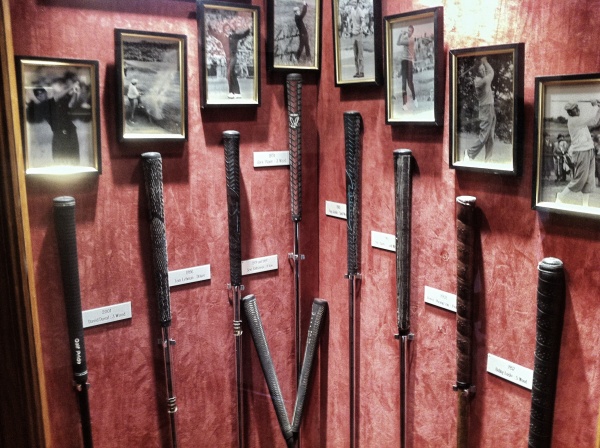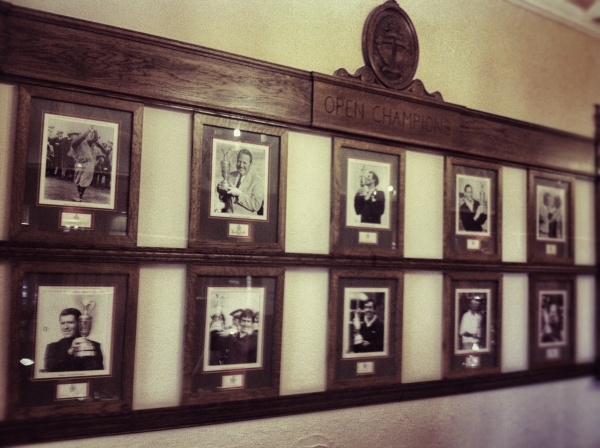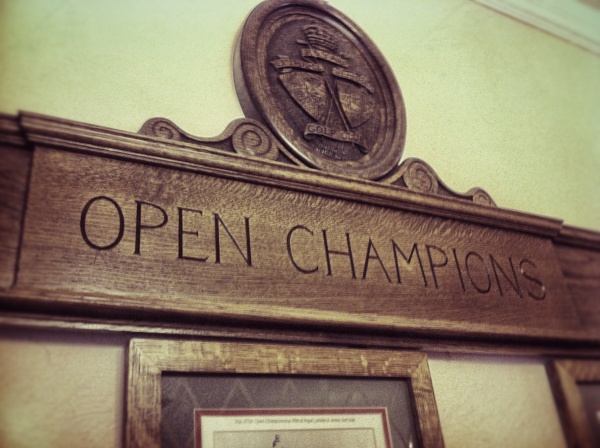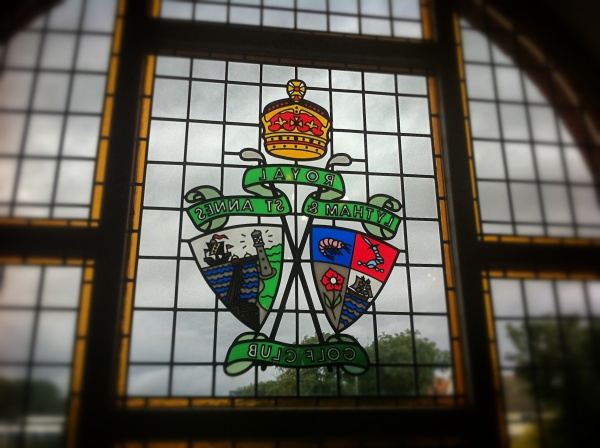When you come to think of it that is the secret of most of the great holes all over the world. They all have some kind of a twist. C.B. MACDONALD
R&A Presser Wrap Up: Forget Portrush, Lytham Draining, Slow Play Killing Game, Twitter & Polo A Fine Partner
/Team Ralph Lauren, a.k.a. the Royal and Ancient's Peter Dawson, Jim McArthur, Johnnie Cole-Hamilton and Malcolm Booth held court sporting great Polo sweaters fresh out of the package (the standards today...manufacturer creases...dreadful).  Some highlights from the annual R&A press conference. Starting with the British press letting no mundane detail slide by…
Some highlights from the annual R&A press conference. Starting with the British press letting no mundane detail slide by…
Q. Do you have more bunker rakers than usual? If so, could you put a number on the bunker rakers, and also can you tell us where these bunkers are that are causing concern?
JIM McARTHUR: Good questions. Peter?
PETER DAWSON: No, I don't think we have more bunker rakers than usual. Each group has a bunker raker that walks with them, and that should be adequate for the purpose. The bunkers that are causing concern at the moment are on the 16th and 17th holes in particular, and there is some concern also on the 14th and on the right of the 2nd green.
When I came here myself ten days ago, thereabout, on a Friday evening, it was much wetter then after the cloudburst than it is now. And two days later of good, drying weather you would think the golf course was in normal summer condition. It was very firm and there was no standing water anywhere.
Dawson called fairways ranging from 18-28 paces on windy linksland...reasonably generous.
The champion on Sunday I doubt will have won from the rough. I think he'll be winning from the short grass, so there's a premium on hitting fairways this week, obviously. But if you stray a long way off the fairways, and the fairways are reasonably generous. If you stray a long way off, then you're going to be penalized.
I later asked about that as a few players who know the course have grumbled about narrowness.
Q. You mentioned that the fairways are generous. Some of the players have noted that the course is narrower than last time and some of the landing areas are under 20 yards. Why has it been narrowed, and does it concern you if we get some of the high winds forecast that it will be too narrow?
PETER DAWSON: I don't believe it's factual that it's been narrowed since last time, I just don't think that's the case. I don't know where that comes from. We have not narrowed any fairways here that I can think of in the setup of the golf course.
It seems the security this week is being handled by the same security firm under fire for their handling of London 2012. And we know how that's going.
JOHNNIE COLE‑HAMILTON: All the managers, the supervisors, the guys in charge who we've been using for many, many years are back with us. The numbers that myself and my team asked for are all here. We have no issue whatsoever with the group force coverage of the golf course. As I understand it, it's a separate part of the business, and it's the event's item. We have no issue at all with the coverage that we've got, and everybody is present and correct.
Here's your first of a few answers on Royal Portrush-as-Open-venue-in-the-future questions that spell its doom.
The Championship Committee looks at many, many factors in determining the course choice for The Open Championship. And we'll just have to see how we go.
There is a great deal and a huge amount of money would need to be spent, in my estimation, to make Royal Portrush a sensible choice.
It requires The Treatment! Go on...
That's not a criticism of Royal Portrush; it's a wonderful golf course. But the commercial aspects of it are quite onerous. And obviously The R&A would need to be sorting those things out as well as just simply the logistics of the whole affair.
It's going to take some time to come to a view, and the view may be no. We'll just have to wait and see. I can't give you a time scale.
JIM McARTHUR: Not before 2016.
Or ever!
And another blow to Portrush hopes here from Dawson:
We don't feel short of Open venues now, let me say. We're not rushing to look for more; we don't feel that pressure. But what did impress hugely about the Irish Open was the logistics worked well, the traffic flows and all of that. But above all, I thought the enthusiasm of the spectators was something not to be forgotten, and that's a very strong point.
Some fantastic stuff here from McArthur, in stark contrast to the other governing body and the tours when it comes to understanding the role of slow play in the game, as influenced by tournament golf.
I have to say to you, we are intent on doing what we can to improve the pace of play in golf. I mean, I think we feel that particularly maybe not so much at professional golf but certainly amateur golf that slow play is, in some ways, if not killing the game, is killing the club membership because of the time it takes to play. And whatever we can do in our events, and bear in mind that we are not seeing the players week in, week out. We see them two or three times a year, professionals once a year, amateurs two or three times a year, we're doing whatever we feel we can in the circumstances to contribute to improving the pace of play.
But it needs to be a concerted effort, not just the R&A, not just the Tours, but the golf unions and other golf organisations to, I think, come to a coordinated effort to improve the speed.
And I think we should ‑‑ personally I think we should be aiming in club amateur golf for three and a half hours maximum for a threeball, perhaps elite amateur four hours. These should be maximum times, and we should be trying to improve these at all times.
 You go Jim!
You go Jim!
Of course, the R&A also has to stop adding back tees and suffocating setups that slow down play, and also make it so that not ever par-5 and a shocking number of par-4s are driveable, therefore clogging up courses.
Dawson on Twitter, rescued sturdily by spokesman Malcolm Booth.
Q. Peter, do you have any concerns about the players' and caddies' use of social media, such as Twitter, given that it seems to be causing more and more travesty in other sporting fields? Will you be monitoring this Championship?
PETER DAWSON: Malcolm, can you take that? This whole subject is entirely beyond me, I must confess, why people feel the need to Twitter, but I'm old‑fashioned. Malcolm, I will hand this question to you.
Q. Do you have an account?
PETER DAWSON: I couldn't afford it.
MALCOLM BOOTH: Well, we do monitor Twitter. We have our own Twitter handle that is pretty successful out there. And of course, we keep an eye on what the players and caddies and connections throughout the game of golf are saying. I can't say I've noticed a huge influx of tweets from the golf course, and I suppose if that started to happen we might take a look at it, but we haven't observed that at this stage.
In an refreshing twist, the R&A is more bullish and proactive then the other members of the Five Families when it comes to people watching coverage on their phones, but they also understand the limitations of current technology. Booth again:
But for the first time people up and down the UK will be able to watch the BBC's domestic coverage wall‑to‑wall Thursday through Sunday on our apps and website, and in America they'll be able to watch ESPN's coverage on our website, and I think that allows us to work closely with our television partners to engage with our audience globally.
And then on a local level, ultimately that will lead to people being able, we hope, to watch television pictures on their mobile devices in the grandstands. That's not something that we will expect to happen for this week, because they'll be reliant on a 3G network, which will only have a certain capacity to watch video, but we hope they'll be able to get live scoring on their devices, as will you, we hope, as you walk round the golf course, but there is every chance that the 3G network ‑‑ we'll have to see how that works.
But over time, as we see how this performs, it's going to become a much‑valued tool to spectators and media around the golf course, and we're very optimistic that it can be a real enhancement at the championship. We're trialling Wi‑Fi on one of our grandstands on 18 to see what the capabilities are of putting Wi‑Fi out in a manageable way out on the golf course, where it actually performs well. And that's something we'll observe over this week, and see what we can do for future years.
 And finally, a question about Team Ralph Lauren's matching sweaters! This should make for fun reading in the tabloids tomorrow.
And finally, a question about Team Ralph Lauren's matching sweaters! This should make for fun reading in the tabloids tomorrow.
Q. You're all looking very smart. Was there a bidding war to outfit The R&A? Just how much did Ralph Lauren pay to take over the merchandising tent?
JIM McARTHUR: Peter, could you answer that for me, please?
PETER DAWSON: Well, I'm not sure we're all looking very smart. No, we're delighted to have Polo, Ralph Lauren as a patron of The Open Championship. And it goes without saying that when you have that sort of commercial relationship, you do expect officials, referees, volunteers, et cetera, to be clothed by them. And that's terrific. Their support of the game of golf, not just here, but other events has been strong, and we're delighted to have them as a partner.
In terms of the financial number, that's obviously confidential and would actually depend on the outcome in the merchandise sales this week, anyway. So I couldn't give you a number even if I wanted to, which I don't.
Q. How many complaints have you had from other merchandisers so far?
PETER DAWSON: Personally I have had none, but I would be surprised if there weren't some flying around.
**Rex Hoggard on how the pace of play situation will be enforced by the R&A, with "words of encouragement."
“We have a pace-of-play policy which we intend to apply stringently,” said Jim McArthur, the chairman of the R&A’s championship committee.
Officials will allow for rounds of 4 hours, 30 minutes for Thursday and Friday’s three-ball groups and 3 hours, 45 minutes for the weekend’s two-ball times, which are ambitious by PGA Tour standards.
After an initial warning, or words of encouragement, players will be penalized a stroke for the second bad time. The third bad time will lead to a two-stroke penalty and a fourth penalty will result in disqualification.
Baker-Finch: “In golf, you’re not supposed to get mulligans, but I got one."
/Telegraph Fiction: Tiger Snaps At British Foes; Offers "Tetchy" Response
/And Yet More Observations From Rainy Lytham...
/Longtime readers know I have a simple rule to determine whether a major championship course setup crosses the goofy threshold: if the fairway landing area off the tee and then leading into a green is narrower than the green complex itself, you have a stinker.
Sadly, more than a handful of key holes at Lytham and St. Annes have been vandalized by paint cans, with a few fairways reaching an unprecedented 18 paces wide, which is as narrow as anything I've seen in the modern age of trying to stifle distance advances through setup.
On a positive note, I spent some time with the holes furthest from the clubhouse and the stretch of eight, nine and ten is magnificent. Meanwhile, the splendid weather drawn up by the Blackpool Tourist Board means the course will never be too fast and firm, making the silly fairway widths slightly more palatable. But if the wind blows, that's another story. Look at longshot bets if some wind creeps into the forecast.
On an even more positive note, I've never seen a club with a greater and more sophisticated devotion to its championships than Royal Lytham. As you'll see below, they have some of the simplest and best displays celebrating past championships that I've ever seen. Pity that the golf course here, so clearly loved by its members and treasured by players for generations, will be tainted this week by a combination of Mother Nature and regulatory ineptitude.
Here are just a few photos from a another gorgeous day in this summer beach resort town. Cheers!
2012 Open Championship: What's A Punter To Do?
/Tiger On Lytham: "There has to be some shape to shots."
/Video: Past Lytham Open Championships
/Rough! Players Told To Quit Their Whinging
/The Telegraph's James Corrigan on Tony Jacklin holding court Monday and suggesting that the players need to quit the their whinging/whingeing (definition for Yanks here).
“You really don’t get the guys in with a shot complaining about the golf course,” said Jacklin, the last Englishman to win an Open Championship on home soil. “It’s controlling the golf ball that wins you majors. If you don’t drive well here you’ve got no chance.”
“Golf courses are to be played. The rough was high at Muirfield in 1966 when Nicklaus won – they had two stewards on the left and right of every hole. He drove with a one-iron all week. Tiger [Woods] won at Hoylake with a one-iron all week. You cannot get out of the fact that it’s controlling the golf ball that wins you major championships and that’s the examination.”
 Ewen Murray of The Guardian quotes Peter Dawson, who is chalking the rough up to the weather and nothing more.
Ewen Murray of The Guardian quotes Peter Dawson, who is chalking the rough up to the weather and nothing more.
Dawson, however, delivered a firm "no" when asked if conditions are unfair. "The rough is up but the course is reasonably generous on width and most of the players seem happy with it, at least those I have spoken to, maybe 20 or so," he said.
"It's nature. We are not starting bailing rough on seaside courses. It grows in the month before the championship. Some years we have a dry summer [and] you get wispy rough; in wetter warmish conditions you get thick rough and a softer course. We don't cut the rough other than the first and second cut."
Meanwhile this was odd, but I'm going to chalk it up to Ian being out at a strange hour and perhaps the greenkeeping crew washing away some clippings.
"When I was out there at 4.50am this morning I did see them watering the rough. I can't even remember on what hole but I was scratching the top of my head thinking‚ 'Wow.'"
Observations And Images From Monday At The Open
/Claret Jug Believed To Be Resting Comfortably Awaiting Surgery At An Undisclosed Blackpool Trophy Shop
/From Paul Newberry's story on defending champion Darren Clarke returning the Claret Jug in slightly worse condition than he found it last year after winning at Royal St. George's.
"It's not quite in as good a condition as I received it in," Clarke said. "It's been here, there and everywhere. But Mr. Dawson looked at it and said, 'Oh, we can fix that, we can fix this.' So it's not too bad."
He was a bit vague on the details of the damage.
"I didn't drop it," Clarke said. "Not in my possession. I shall say no more. It was nothing to do with me. (But) it's not that bad."
Punters Beware: Harrington The "Inveterate Tinker" Has A Quieter Mind These Days
/Jacklin On Coaches Today: “There’s so much bull*&%$"
/Ogilvy On Lytham: "It is a sort of 'non-seaside' links."
/ Geoff Ogilvy on playing Lytham in 2001 and other memories of the place he first saw in 1996.
Geoff Ogilvy on playing Lytham in 2001 and other memories of the place he first saw in 1996.
Still, while the first nine at Lytham is no pushover, it is the back nine that sticks in the memory. The six-hole string of par 4s heading home, after the potentially card-wrecking par-3 12th, is a stretch any golfer will be glad to play even par if the prevailing breeze is blowing. I know that to be true. In 2001 I was back at Lytham, this time to play in the Open. I missed the cut, but I recall enjoying the challenges presented by that tough inward half.



